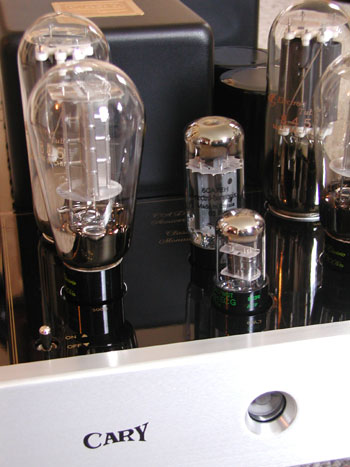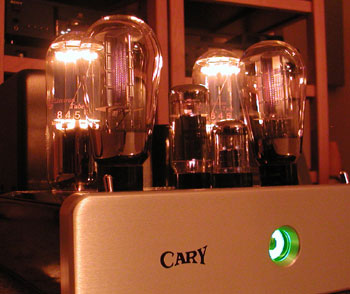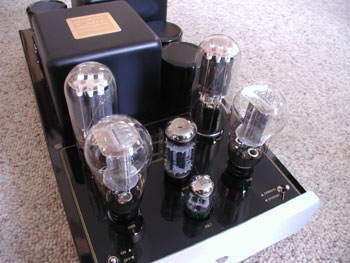|
You are reading the older HTML site Positive Feedback ISSUE 11january/february 2004
cary audio 211 Anniversary Edition amplifiers as reviewed by Robert H. Levi with a few additional comments by Dave Clark
|
||
|
|
Dennis Had, President of Cary Audio, and I have had a running gag for about fourteen years. Every time I see him, I ask him if he has developed any triode amplifiers that will power speakers like my big, 87 dB-efficient Avalon Eidolons. His answer has always been firmly, "Not yet," but when I saw Dennis at the Home Entertainment Show in San Francisco earlier this year, I did not even have to ask. He walked straight up to me and announced that he had a pure triode amp that would drive the Avalons to the max. They would be coming off the assembly line in late September and the first pair was mine to review. Dennis has been building the Cary 211s since 1993 and incorporating new thinking into them over the years. He admits that the new 211 Anniversary Editions are very different from the originals, and incorporate everything he has learned to date. To quote Dennis, "The Cary 211 Anniversary Edition is the best sounding amplifier in the entire Cary line." Considering the accolades his designs have received recently, particularly the 805C Anniversary Edition and the V12, for him to go on record saying the new 211s are the best is very exciting. Dennis did not equivocate, so neither will I as I describe to you the sonic prowess one discovers with almost limitless triode power. The 211s employ a big pair of 845 output tubes run in push-pull class A to 70 watts, class A1 to 110 watts and beyond, with zero feedback. They are not self-biasing, and clear instructions are provided for adjusting bias. The driver tubes are a pair of 300Bs, the input tube is a single 6SL7, current source tube is a 6CA7, and there is a 1629 "cat’s-eye" tube on the front panel for power indication. 4-,8-,and 16-ohm speaker connections are provided. A detachable power cord, single-ended and balanced inputs, a brightness control for the cat’s eye, standby and power switches are all provided. The power transformer has a 300 percent duty cycle and is impregnated with silicon wax to eliminate vibration. The output transformer has a 200 percent duty cycle, silicon wax potting, and the capacitors are oil filled. You cannot add feedback as in other Cary designs, as feedback causes listening fatigue due to the absolute purity of the sonic output, quoth Dennis. The amps weigh 90 pounds per chassis, and need 200 hours break-in. I put them on Zoethecus amp stands, using their huge, custom sorbethane-like feet.
When you turn the 211s on, you get a light show unlike that of any other tube amp. Each 845 puts out about 10 watts of light and there are two per unit. I loved the look and overall refinement of the units. The fit and finish is gorgeous. To me, each looks like a shotgun 805C, but could this 211 Anniversary amp perform better than the 805C with more than double the power? Could it be the state of the art in pure triode tube design? Listening to the Telarc SACD of Carmina Burana, I realized that the 211 IS a shotgun 805C in power output. The 211 has huge, unclippable power reserves. I drove myself out of the room trying to find the ultimate output of these amps. The bass was so magnificent and powerful, I reduced my REL sub to half its normal output. No triode amp I have ever heard has the bass definition and sheer grunt of the 211s. Only a few non-triode tube amps can match this. The width and height of the choral piece were huge. No amp I have heard on the Avalons has produced a bigger soundstage. The illusion of a full-scale orchestra and chorus in the room was thrilling. The vocal colors and instrumental textures were beautiful, defined, smooth, and grain free. The amps are also dead quiet. Music emerges from a background as silent as that of top solid state designs. Imaging is very good to excellent, and depth is very good. Though top notch, the 211s do not quite give the listener as extraordinary a reproduction of depth that they give of height and width. I tried several cables, including Kimber Select and Soundstrings, but could not find that ultimate clarity of great depth. Micro-dynamics were as good as they get. Macro-dynamics were very good to excellent. I’m nitpicking here—I was so blown away by the sheer sonic size and realism of these amps, I set great expectations for their other parameters. As I listened to the solo voices, I reveled in the texturing and delicacy of these amps. The individual voices sounded slightly soft focus, enhancing the airiness of the recording. Super Bass 2 from Telarc (SACD 63483) is a sonic challenge. It has a you-are-there club feel with incredible imaging and wondrous texturing from the three basses. On the 211s, space and air were A+, definition A+, width and height A+, depth A, lack of colorations A, and overall definition A. Bass bowing was realistic and ultra textured. All was natural and alive. No hint of nits to pick, just state of the art bass from a triode tube design. Bravo. Listen to La Stravaganza from Channel Classics (SACD 19503) for the joy of it. Spacial cues and pure sweet string instruments are done as well as you could expect, with zero grain and glare. The lack of any identifiable coloration was refreshing. The layering of the instruments and the definition were top notch, and the lack of digititus was a delight. The soloist is sitting with the orchestra, but was clearly heard. Though the imaging was very good to excellent, I would have preferred a bit more focus overall. The sound was not as patently neat and tidy as feedback-based tube amps. I think this all comes down to a matter of taste, but I do wish a feedback control was included for personal tweaking. Nevertheless, the sound of this disc was so good on the 211s that you could put your SACD on repeat, wall up the room, and never want for more. Try the new Telarc Firebird (SACD 60039) and fasten your seat belt. The low bass was tight and textured, the violins luscious and warm, the staging huge, and the dynamics explosive. My 600-watt Pass amps did not reach bigger cresendos. You could not ask for more definition. The instrumental colors are spot on, and you will love the 3D clarity of the presentation. If you have never heard 100+ watts of pure triode power, you just don’t know. You have to hear these amps on this SACD. I truly loved the micro-dynamics. When the orchestra was playing full tilt, I was stunned by the sheer beauty of it all. This is THE tube amp for big orchestra, pop, and jazz recordings. It will rock your world and yield low fatigue, even with less than stellar recordings. With the best stuff, like this Firebird or nearly any Telarc recording, the enjoyment factor is consistently 9.5 out of 10. Next up was John Coltrane in Blue Train, a new SACD re-release. The stunning solo work in the first cut was very exciting. The instruments were real enough, but a bit too big. This is very subjective, though I did not hear this disc sound like this on any other system I tried. The Carys’ triode sound will cause you to try different speaker positioning to focus and refine what you are hearing. To get this SACD right, I increased the toe-in of the Avalons by half an inch. Focus improved as well as soundstaging. I was impressed with how the 211 made me rethink the hobby. Triode designs from VTL do not behave like this, but also don’t have such powerful musical presence. The Nagra amps are similar in punch, but the 211s are unique in my experience, as they are triode designs packing tetrode slam. I have become accustomed to the sound of the Lauridsen CD, RCM 19705. It exudes lovely vocal textures and long ambient delays. The voices were rock solid and clear with the 211s, greatly enhancing the choral work and my enjoyment of the selections. The bigger the presentation, the better the 211s sound. With the increased toe-in, I felt more secure of the accuracy and musicality of the sound. Cut ten, on which Morten Lauridsen is playing the piano, is hauntingly beautiful. The piano, unmiked, still focuses stage center. Try this cut as a way to check coherence in your system. The lack of coloration and phasiness in the 211s were apparent. I listened to the CD twice. Now for the delicate. I played Sonata for Violin and Piano, Wilson Audiophile CD, 8722. This features a Guarnerius violin and a Steinway D piano in a warm, ambient setting. The instruments are not closely miked, and the recording is all analog. Delicacy and musicality are paramount, not power or vividness. I’ve heard few—and I mean few—amps sound as winning on this CD as the 211s. There was no mistaking the intensity of the instruments or the texturing and pace of the sound. It was exciting, maybe too exciting, but this is a high-class problem. After all, I have no idea what an accurate rendition may be. All I can say is that the sound was intensely realistic and enjoyable from a 16-bit source—no small feat, but the 211s are no small amps. This is the pure, powerful triode amp you’ve waited for. It will power any speaker I know of, regardless of type or efficiency. Its sound is both triode big and triode delicate, and that’s quite a trick. At $15,000 it’s pricey, but the construction and musicality give high confidence that this effort at scaling Mt. Olympus is worth every nickel. The Cary 211s are one of the five or so best tube amps on the planet. Happy anniversary, 211s! Robert H. Levi
How good are the Cary 211s you ask? Well good enough that I was tempted to take out the check book and buy these after a week of listing. Why didn’t I you ask? Because at $14000 a pair and being an elementary teacher in LAUSD, my income and that of my wife combined (also a teacher—same school too!) clearly said otherwise. Heck even being the high powered and revered Editor of PFO was not enough to get things a permanent resting place in my system. But yes, they are that good. Way better than the Clayton M100s that have stood the test of time and the competition from the likes of the Pass X250, Simaudio Moon W-3, Aria Audio WT100 XL LS, Joule Electra Stargates, Majeel Laboratories Pristine SA10, Marsh Sound Design A450M, and the McIntosh MC352 amplifiers. Even though each of these amplifiers brought their own special charms and strengths to the table, I was always happy with the Claytons—even though they are a bit aged in terms of the newer designs coming out. Why the Cary 211s? Because with the music we play, they simply rock. I did find that you will have turn the preamp up a bit (even at their 70 watts I could never get them to clip or flip over to class A/B no matter what I played or how loud) before they will really amaze you—but that is perhaps more me than anything else as these amps are way to fun to be legal!. But at more normal or sane listening levels, they still sounded wonderful. The wonderful thing is that when things get loud and scary, they simply will amaze at their ability to open up and fill the room with music lacking any hint of compression, strain, or distress. They actually sounded better the louder you played them! Bass was considerably more tight and extended with a wallop that was the opposite that their tube compliment would indicate. All this from a pair of 300Bs and 845s? Dennis, how you do that?! Compared to the Claytons things just moved at such a pace with such a degree of "aliveness" that I never could sit still for too long. Shit, these are truly wonderful amplifiers. Even my 15 year old son had to listen to his choices for music nirvana (Mushroom head, Tool, etc.) and found that the 211s easily made the M100s sound more lackluster and boring than we could ever have thought. Just goes to show you what one can do with old tubes and few chosen parts! I really do not want to go on and one here, as Bob hit the nail right on the head—these are of reference quality and have few peers at any price. That is musical peers, which is all I really care about! Dave Clark Cary Audio Design
|



